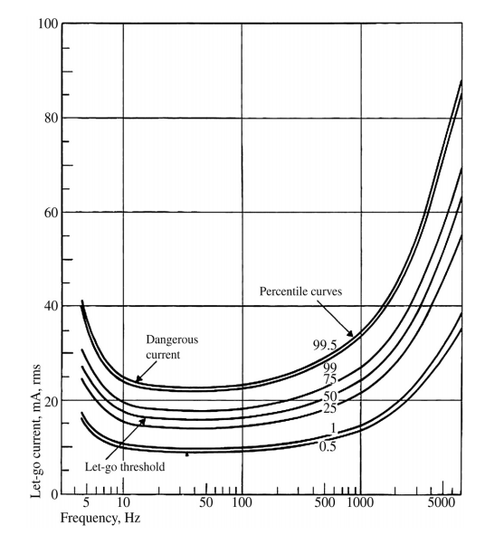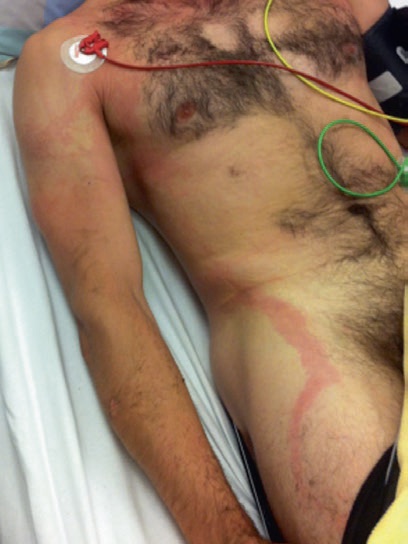Electrical Injury
Electrocution causes a variety of injury patterns depending on the:
- Current size
Determined by:- Current source
- AC
Maximal risk at ~50-60Hz.- Low-voltage
Typically at homes or offices.- May cause loss of consciousness
- High-voltage
Typically industrial.- Extensive thermal burns
- Violent muscle contraction may cause further injury
- Low-voltage
- DC
- Violent muscle contraction may cause further injury
- Much less likely to cause VF than AC current
- Conducted electrical weapons
Typically tasers, and similar devices.- Injuries due to consequences of the shock
e.g. Falls.
- Injuries due to consequences of the shock
- Lightning strike
Very high voltage, short duration static electrical discharge.
- AC
- Tissue resistance
Significant determinant of injury.- Wet skin has 1000 times less resistance than dry skin
- Medical devices that breach skin (e.g. IV lines) significantly ↑ susceptibility
- Classified into two types based on ability to induce VF:
- Microshock
Induce VF when applied directly to myocardium; typically ~1ma. - Macroshock
Induce VF on surface contact; typically ~100mA.
- Microshock
- Current source
- Current duration
Function of current source.

Causes of microshock include:
- Pacing wires
- Pulmonary artery catheters
- Central lines
- Arterial lines
- IV lines
- Static shock from staff
Epidemiology and Risk Factors
Risks:
- Majority occur in:
- Workplace
60%. - Home
50%.- Children <6 at highest risk
- Workplace
- Powerlines
- Electrified railway tracks
Pathophysiology
Aetiology
| Current (A) | Source | Effects |
|---|---|---|
| 10-100μA | Earth leakage current | Microshock (VF) |
| 300-400μA | Equipment fault | Tingling |
| >1mA | Equipment fault | Pain |
| >10mA | Equipment fault | Tetany |
| >100mA | Equipment fault | Macroshock (VF) |
| >1A | Equipment fault | Burns |
| >5A | Equipment fault | Sustained asystole |
| >1000A | High-tension powerline | Severe burns Amputation |
| >12,000A | Lightning | Coma Burns Amputation |
Leakage currents are low-amperage currents that flow to earth due to imperfect insulation or coupling between electrical and magnetic fields around an AC source.
They are generally harmless, but have capacity to cause microshock.
Clinical Features
Injuries can occur due to:
- Depolarisation of muscle cells
- Cardiac
- VF
- Asystole
- Skeletal muscle
- Violent movement
- Tetanic contraction
- Prevents letting go
- May prevent respiration due to tetanic diaphragmatic or intercostal contraction
- Cardiac
- Vascular injury
- Thrombosis
↑ Risk of small vessel injury.
- Thrombosis
- Neurological injury
Due to:- Cardiorespiratory arrest
- Direct injury
Current passing through brain. - Secondary trauma
- Burns
May be extensive and include:- External electrical burns from arcs
- Internal burns due to tissue heating
- Thermal burns from heated jewelery or flammable clothes
- Flash burns
Defibrillators rely on asystole occurring at sustained currents >5A.


Transient phenomenon, pathognomic of a high-voltage electrical injury (classically lightning strike) that occurs due to capillary rupture and T-cell activation.
Diagnostic Approach and DDx
Investigations
Investigations are tailed towards detecting consequences of injury.
Bedside:
- ECG
- Myocardial injury
Laboratory:
- Blood
- FBE
- UEC
- AKI
- Coag
- CK
- Troponin
Imaging:
Other:
Management
- Safety of rescuers
- CPR even if initial prognosis poor
- Protect spine
Resuscitation:
Specific therapy:
- Pharmacological
- Procedural
- Physical
Supportive care:
Disposition:
Preventative:
Marginal and Ineffective Therapies
Anaesthetic Considerations
Complications
- C
- Myocardial injury
- Global LV dysfunction
- Myocardial infarction
- D
- Cataracts
- F
- Rhabdomyolysis
- AKI
- Myoglobinuria
Prognosis
Key Studies
References
- Bersten, A. D., & Handy, J. M. (2018). Oh’s Intensive Care Manual. Elsevier Gezondheidszorg.
- Lindford A, Juteau S, Jaks V, Klaas M, Lagus H, Vuola J, et al. Case Report: Unravelling the Mysterious Lichtenberg Figure Skin Response in a Patient With a High-Voltage Electrical Injury. Frontiers in Medicine [Internet]. 2021 [cited 2023 Sep 27];8.